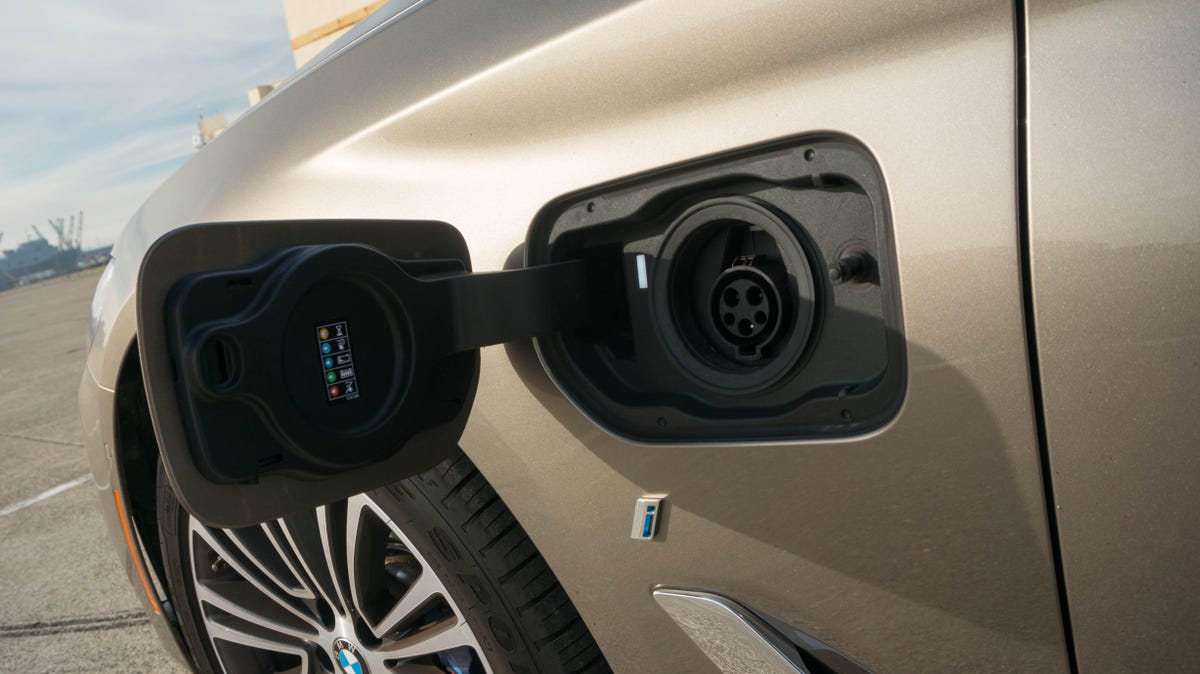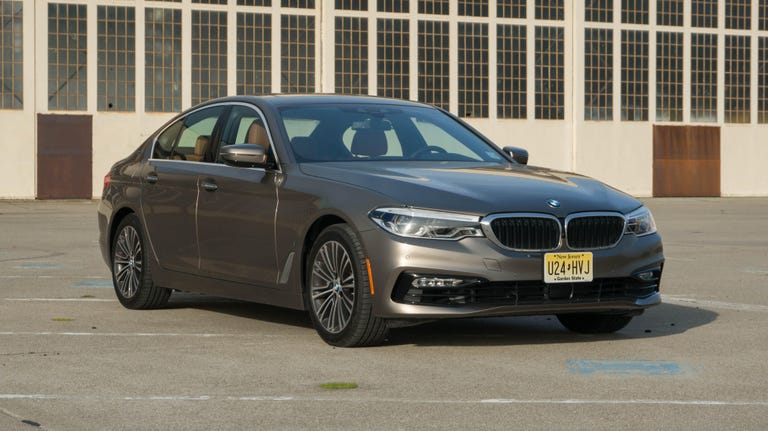 Why You Can Trust CNET
Why You Can Trust CNET 2018 BMW 5 series review: BMW's plug-in 530e is more practical without a price premium
Could this be the best BMW 5er without an M badge? It's almost certainly the most sensible.
At the beginning of my week with the 2018 BMW 530e iPerformance, I questioned the point of this hybrid version of the 530i I'd reviewed earlier this year. The horsepower figures are identical and the combined fuel economy estimate, at 29 mpg, is just two mpg more than the non-hybrid. What's the point?
The Good
The Bad
The Bottom Line
By the end of the week, the electrified 5er had made a believer out of me. The details that changed my mind are twofold. First, the charging port on the front fender opens up a whole new world of efficient driving for those who plug in and plug in often. The kicker, for me, is the price. BMW lists the starting prices for the 530i and 530e as the same. With no premium, is there any reason not to go hybrid?
2.0-liter eDrive powertrain
The 530e iPerformance is powered by the same 2.0-liter BMW TwinPower Turbo inline four-cylinder as the non-hybrid 530i, only this application has been retuned slightly for improved fuel efficiency.
Power from the gasoline engine is down to 180 horsepower and 255 pound-feet of torque, but that's before the addition of the extra 111 horsepower and 184 pound-feet from the eDrive electric motor. Total power output for the system then climbs back up to 248 horsepower, matching the non-hybrid. (If it seems like those numbers don't add up, it's because the two motors make their peak power at different rpms, complicating the hybrid math.) The 530e's combined 310 pound-feet of torque actually gives it a 52 pound-foot improvement over the 530i.
You'll likely not notice much of that torque advantage due to the increased weight of the hybrid system and batteries (520 pounds more). Of the line, the 530e is slightly smoother, but its BMW-stated 0-60 mph time matches the lighter 530i at around 6 seconds.
The e-motor replaces the torque converter between the gasoline engine and the single-option eight-speed automatic transmission, which aids in supersmooth transitioning between electric and assisted driving and smooth gear changes. I hardly noticed the gasoline engine fire up without watching the digital gauges and, overall, the 530e performs like a quieter, more refined version of the 530i.
The ride, too, is softer and smoother. The suspension retune to compensate for the additional 520 pounds of weight has left the 530i's handling just a tad softer than that of the non-hybrid. On the positive side, that means the hybrid feels more relaxed on the highway and smoother over bumps around town. This sort of works well with the relaxed and torquey power train, but makes the 530e feel more like the Ultimate Cruising Machine.
Plug in to power and range
Electricity to power the iPerformance's eDrive electric motor comes from a combination of regenerative braking, generation by the gasoline motor and plug-in charging.
The excited electrons are stored in a 9.2 kWh high-voltage lithium-ion battery pack that lives in the sedan's boot, leaving 530e drivers with about 4 cubic feet of cargo space less than their 530i-driving neighbors. That's not the end of the world; there are still 15 cubic feet left and BMW has managed to preserve the fold-down rear seats to accommodate longer items.
BMW conservatively states around 15 to 16 miles of pure electric driving, which is backed up by the EPA's estimates. Going hybrid also shrinks the 5er's gas tank capacity from 18 gallons to 12 gallons. However, between the electric and gasoline ranges, you've still got about 375-ish miles of motoring before you need to refill the gasoline tank or recharge the battery pack.

The 530e iPerformance can be plugged in and recharged at a 240V J1772 charging station through its 3.5 kW AC charger in about three hours. It also includes an "Occasional Use Cable" for use with standard 110V wall outlets in a pinch. This method steps down to 1.4 kW charging and takes about five to six hours.
Fully charged and under full electric power, the 530e averages an EPA-estimated 72 mpge for those first 16 or so miles. Then the gasoline engine kicks in and the economy drops to 29 mpg until you run out of gas. Of course, your mileage will vary depending on how often you recharge.
Lacking a plug at home, I used only public stations for two full charges during my 267 total miles driven and ended my week at an average of 31.7 mpg combined. An owner with a plug in the garage or one at the office should do a whole lot better than I did and better than the EPA's 27 combined mpg estimate for the non-hybrid, so I'm calling this an efficiency win.
eDrive modes
BMW's all about customizable drive modes on the performance side and the iPerformance hybrid is no exception. In addition to the Comfort, Sport, Adaptive and Eco Pro drive modes from the standard 5er, the 530e also features a trio of eDrive modes that adapt how the hybrid system makes use of battery power.
Auto eDrive is the default and automatically switches between gasoline and electric power depending on the conditions. This usually means using up the battery first, then switching over to gas. This mode will fire up that gasoline engine if you tip too deeply into the throttle, allowing both engines to work together for acceleration.
However, you can switch to a Battery Control mode that preserves the battery's charge at a user-set level by switching over to gasoline power -- useful, for example, if you want to save most of your e-driving for the urban area at the end of a longer highway commute.
The third mode, Max eDrive, attempts to use only electric power until the battery level drops low. In this mode, you can reach a top speed of 87 mph on e-power alone. The system will kick the gasoline engine over if you dip too deep into the throttle or exceed 87 mph, but the limits are much more generous in Max eDrive.
iDrive version 6.0
Aside from the electrified powertrain, the 2018 530e is nearly identical to the last 530i that we tested. The new 5er gets almost all of the new tech goodies from the new 7 Series: New iDrive, new safety tech, new head-up display and a new gesture control system to play around with.
The automaker's iDrive infotainment gets a version 6.0 redesign based on the setup we saw in the new 7 Series. The system features crisply rendered visuals, smooth animations and a new home screen with large virtual cards that explain the major sections of the interface, including navigation, media and vehicle information. The cards help a bit as you learn your way around the interface, but I still found it a bit confusing at times. That said, I'm grateful that it's so much better than it used to be.
The system's 10.2-inch touchscreen can also be operated via the console-mounted iDrive controller and a touchpad on the iDrive knob can be used to write, swipe and pinch, or voice command. I personally felt the controller was more intuitive and it kept fingerprints off of the central display. Plus, I've been using one version or another of this knob for six generations now, so I'm accustomed to it.
The most gimmicky new control scheme is the new gestures system that allows drivers to interact with iDrive without even touching it. Twirling a finger in front of the dashboard, for example, raises or lowers the audio volume. Waving a hand dismisses a notification. There are more gestures available but, aside from the finger twirl volume control, I found it easier and more accurate to just use physical controls for most interactions.
Overall, the iDrive tech is pretty amazing stuff and a substantial upgrade over the last time I saw the 5er. Even wireless Apple CarPlay is available for this generation, a first for the industry. Though, in typical BMW fashion, it's a $300 optional upgrade. Android users are neglected by BMW for yet another generation; there's no Android Auto upgrade available.
In addition to the reconfigurable digital instrument cluster ahead of the driver, our 530e also came equipped with a full color head-up display. Projected directly into the driver's field of view on the windshield, the HUD displays speed and safety information as well as turn-by-turn navigation with bright, colorful graphics that helped me to keep my eyes on the road. However, if you wear polarized sunglasses while driving during the day, expect the HUD's vibrancy to be diminished significantly.
Safety force field
Our optioned-up 530e came equipped with more cameras than I knew what to do with. There's the rear camera, the front bumper camera, side curb-view cameras, and other modes that use digital sorcery to stitch together a 3D bird's-eye around view of the area around the car. With so many cameras and a plethora of sonar proximity sensors, parking the 5er is as easy as pie. But if you need a little more help, there's also semiautonomous active parking assist -- though I found that system trickier to activate and operate than just doing it myself.
There's also collision-mitigating automatic emergency braking with pedestrian detection and rear cross-traffic alert to help keep the 530e safe in the city.
However, driver aid tech isn't just limited to low-speed operations. Features like lane-keeping assisted steering, blind-spot monitoring, driver alertness monitoring and adaptive cruise control -- which even works in stop-and-go traffic -- help make the highways safer as well.
A subtle addition to this generation's safety tech suite is a single button on the dashboard -- a car surrounded by a glowing green circle -- that lets you instantly toggle all of the equipped safety features (or a preselected set of them) with a single touch. I first saw such a "safety force field" button on Infiniti cars and am glad to see the simplified interface in Bimmer's bag of tricks.
I should mention that the 5 Series is available with optional night vision that can display a monochrome, infrared view of the road ahead at night on the digital instrument cluster, but I found that the optional LED headlamps with automatic high beams and adaptive steering were, for me, a better solution to this problem.
Premium pricing without the premium
The 2018 BMW 530e fills an odd role within the new 5 Series lineup. It doesn't really present itself as an upgrade over the 530i. It's more an alternative -- a slightly greener side of the same Ultimate Driving Machine™. The lighter non-hybrid offers a tad more potential for driving thrills, but the hybrid makes up for its softer ride with more potential for fuel-efficient driving.
BMW's configurator lists the 2018 530i and 530e at the same $52,400 starting price for the rear-wheel-drive sDrive model and $54,700 for xDrive AWD -- though there are slight differences in their options packages beyond -- so there's almost no reason not to go hybrid if you're a more relaxed driver who's already looking at the 2.0-liter 5er.
Of course, it's a Bimmer, so options aplenty mean that it's highly unlikely that your 530e will start so low. Bimmer is a brand that I've complained endlessly about for nickel-and-dime "upgrades" such as $300 for Apple CarPlay, a feature that is often standard on budget vehicles these days.
With its Premium and Executive packages, BMW Individual color options, driver assistance packages, brake upgrades and other options, our 2018 530e xDrive iPerformance Sport Line tips just over the $72,000 mark when you include the $995 destination charge. It's pricey, but no more so than the non-hybrid.


